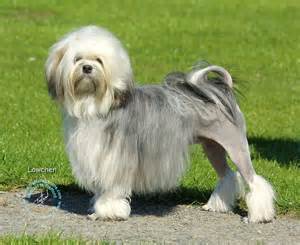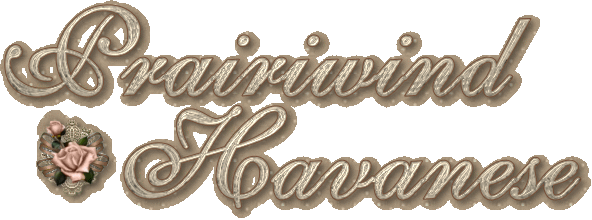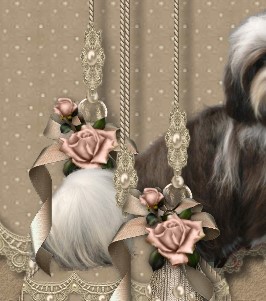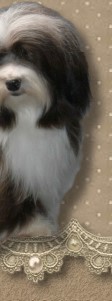 Havanese History Havanese History
The Havanese dog is part of the Bichon canine family of small breeds which probably originated in the Mediterranean area in pre-Christian times. All Bichons are descended from the same bloodlines that produced the Barbet, or water spaniel; the Poodle; the Portuguese Water Dog; and others. The Barbet or "Barbichon" - later shortened to Bichon canine family - consists of several distinct breeds, including the Havanese. In order of popularity in the U.S., these breeds are: 1)Maltese, 2)Bichon Frise, 3)Havanese, 4)Lowchen, 5)Coton de Tulear, and 6)Bolognese.
During the days of the Spanish empire, Bichons traveled to Cuba with sea captains who used them as presents for the women of Cuban households. By gaining entry into wealthy Hispanic homes, which were otherwise closed to outsiders, the captains were able to establish lucrative trading relationships with rich Cuban families.
Once in Cuba, the Havanese dogs (Habeneros in Spanish) lived exclusively in the mansions of the highest social class of people. Havanese dogs were never raised commercially or sold, but were sometimes given as precious gifts to a friend or someone who had performed a valuable service. Like the Victorian-age wealthy Hispanic women who owned them, the dogs were not seen in the streets or public areas. They lived in the rooms and interior courtyards of their tropical homes and occasionally rode in carriages with their owners.
The Havanese dog found its way to Europe where it became very popular and was recognized by the European Kennel Club. It was known in England as the "White Cuban". Queen Anne is said to have admired a troupe of performing Havanese dogs that danced to music in almost human fashion.
As happened to many other dog breeds, the Havanese' popularity waned over the course of time. For awhile they were used in circuses as trick dogs throughout Europe, but eventually they became almost extinct - even in their native Cuba. Only three families were known to have left Cuba with their Havanese dogs during the political turmoil of the 1950s and 1960s. It is assumed that by that time there might not have been very many of these dogs kept by anyone. These three exiled families worked alone in Florida and in Costa Rica for over a decade to preserve the breed.
After raising Irish Wolfhounds and Soft Coated Wheaten Terriers for many years, Dorothy and Bert Goodale of Colorado began looking for a small breed to raise which would have the calm temperament and intelligence they cherished in the larger breeds. After a few years of investigation, elusive references to the Havanese dog had drawn their attention, but no one knew where the Goodales might obtain them.
In the mid 1970s, they chanced upon an advertisement which resulted in the purchase of six pedigreed Havanese dogs; a mother, four daughters, and an unrelated young male. Completely enchanted with the outgoing, intelligent, and affectionate nature of the breed, they endeavored to locate more of the little exiles.
Mrs. Goodale placed advertisements in Latin papers in Miami offering to purchase Havanese. After several months, she had received only one response. A Florida man wrote to say that a friend of his had five Havanese dogs that he wished to sell. Mr. Eziekiel Barba had fled Cuba and settled in Costa Rica. Because of failing health, he had decided to move to Texas to live with his daughter and could no longer care for his "brood" of Havanese.
The Goodales arranged to purchase Mr. Barba's five dogs. This second Group had the same look and gentle temperament as the first. This gave the Goodales two new bloodlines to work with. Both the first and second group of dogs displayed the same look; sweet gentle temperament and were of similar size (as adults, averaging 10 to 12 lbs and 9 to 10 inches tall). Using the 1963 FCI Breed Standard (the only standard available), Mrs. Goodale began a breeding program to prevent the extinction of this breed. We who have come to know and love the Havanese breed, will be ever grateful to Dorothy Goodale for her efforts.
Havanese dogs are also making a comeback in its native Cuba. The Bichon Habanero Club is working from a foundation stock of approximately 15 dogs and is closely supervising the breeding program. In 1997 the first Havanese dog was exported from Cuba to the Netherlands.
Related Breeds
Maltese

Phoenician traders probably brought this ancient breed to Malta more than 2000 years ago. The Maltese of today is one of the sweetest of the toy breeds. It is a very sweet-natured, good tempered, lively little dog that is full of fun. Much of its physical appeal comes from the startk contrast of large dark eyes and a black button nose set off against an immaculate floor-sweeping pure white silky coat.
Bolognese

Though this breed may have been developed in Southern Italy, it takes its name from the northern Italian city of Bologna where it was especially popular. Descriptions of this breed have been recorded since the 1200's. The Bolognese closely resembles the Maltese and served a similar role of companion among the ruling families and aristocracy of Renaissance Italy. Its stocky, compact body is covered with a soft white cottony curly coat. Like all bichon breeds, it is
very sweet, affectionate and devoted to its family. The bolognese is a somewhat serious little dog who is slightly more docile than its more popular cousin the Bichon Frise. It is quite rare today, even in its native Italy.
Bichon Frise

This breed originated in the Mediterranean in the middle ages. By the 14th century, sailors had introduced it to the island of Tenerife, and by the 15th century it was a royal favorite. It is a small, sturdy powder puff of a dog with a merry, happy-go-lucky temperament. Masses of pure white, soft corkscrew ringlets provide the perfect backdrop for its dark almond eyes and jet black nose. The Frise is a very happy, lively, bouncy companion.
Coton de Tulear

Related to the French Bichons, and the Italian Bolognese, the Coton arrived in Madagascar in the 1600's with French troops or with the administrators that followed. There it developed into a distinct breed. Many of the physical characteristics of the Coton are similar to the Bichon Frise. For centuries it was the favored companion of the wealthy residents of Tulear in Southern Madagascar. It is often known as the "Royal Dog of Madagascar". The Coton is covered with a light-textured cotton-candy fluffy white coat. Unlike its all-white European cousins, the Coton may have lemon or black patches or tipping. Its popularity is growing in Europe and America.
Lowchen

The Lowchen's origins lie in the Mediterranean in the 14th century. It has progenitors through the countries of Southern Europe most notably France, Spain and Italy. It is often referred to as "The Little Lion Dog" because of it's traditional clip that gives the dog the appearance of a small lion. It's coat comes in an assortment of colors. The modern Lowchen is the enigma of the Bichon family. Though it does exhibit some of the typical Bichon traits, a number of other characteristics are unique to the Lowchen and not found in any of the other related breeds. It's square body, semi-harsh outer coat and spunky boisterous nature seem to suggest a strong terrier influence. To further confuse the issue of classification, there is evidence that a lion-type trim was frequently used on many dogs other than the Lowchen (including the Maltese).

|



